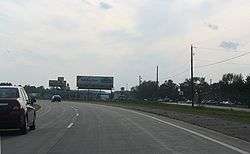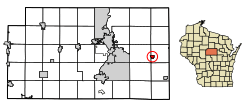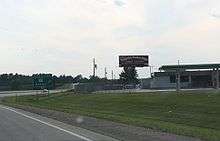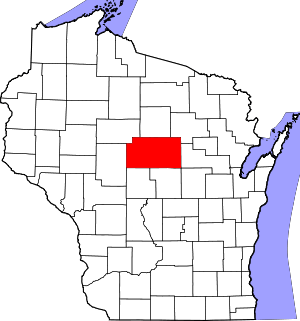Hatley, Wisconsin
Hatley is a village in Marathon County, Wisconsin, United States. It is part of the Wausau, Wisconsin Metropolitan Statistical Area. The population was 574 at the 2010 census.[6]
Hatley, Wisconsin | |
|---|---|
 Looking west at Hatley along WIS 29 | |
 Location of Hatley in Marathon County, Wisconsin. | |
| Coordinates: 44°53′11″N 89°20′23″W | |
| Country | |
| State | |
| County | Marathon |
| Area | |
| • Total | 0.98 sq mi (2.53 km2) |
| • Land | 0.98 sq mi (2.53 km2) |
| • Water | 0.00 sq mi (0.00 km2) |
| Elevation | 1,270 ft (387 m) |
| Population | |
| • Total | 574 |
| • Estimate (2019)[4] | 597 |
| • Density | 611.05/sq mi (236.04/km2) |
| Time zone | UTC-6 (Central (CST)) |
| • Summer (DST) | UTC-5 (CDT) |
| Area code(s) | 715 & 534 |
| FIPS code | 55-33175[5] |
| GNIS feature ID | 1566132[2] |
History
A post office called Hatley has been in operation since 1881.[7] The village was named after Hatley, Quebec, the former hometown of an early settler.[8]
Geography
Hatley is located at 44°53′11″N 89°20′23″W (44.886377, -89.339605).[9]
According to the United States Census Bureau, the village has a total area of 1.05 square miles (2.72 km2), all of it land.[10]
Demographics
| Historical population | |||
|---|---|---|---|
| Census | Pop. | %± | |
| 1920 | 290 | — | |
| 1930 | 251 | −13.4% | |
| 1940 | 270 | 7.6% | |
| 1950 | 299 | 10.7% | |
| 1960 | 306 | 2.3% | |
| 1970 | 315 | 2.9% | |
| 1980 | 300 | −4.8% | |
| 1990 | 295 | −1.7% | |
| 2000 | 476 | 61.4% | |
| 2010 | 574 | 20.6% | |
| Est. 2019 | 597 | [4] | 4.0% |
| U.S. Decennial Census[11] | |||
2010 census
As of the census[3] of 2010, there were 574 people, 223 households, and 160 families living in the village. The population density was 546.7 inhabitants per square mile (211.1/km2). There were 233 housing units at an average density of 221.9 per square mile (85.7/km2). The racial makeup of the village was 94.9% White, 0.2% African American, 2.6% Native American, 1.0% Asian, 0.3% Pacific Islander, 0.2% from other races, and 0.7% from two or more races. Hispanic or Latino of any race were 2.4% of the population.
There were 223 households, of which 34.1% had children under the age of 18 living with them, 60.1% were married couples living together, 6.7% had a female householder with no husband present, 4.9% had a male householder with no wife present, and 28.3% were non-families. 20.2% of all households were made up of individuals, and 5.8% had someone living alone who was 65 years of age or older. The average household size was 2.57 and the average family size was 3.00.
The median age in the village was 34.3 years. 26.3% of residents were under the age of 18; 7.6% were between the ages of 18 and 24; 34.3% were from 25 to 44; 20.2% were from 45 to 64; and 11.7% were 65 years of age or older. The gender makeup of the village was 53.1% male and 46.9% female.
2000 census
As of the census[5] of 2000, there were 476 people, 185 households, and 133 families living in the village. The population density was 532.6 people per square mile (206.5/km2). There were 193 housing units at an average density of 216.0 per square mile (83.7/km2). The racial makeup of the village was 97.48% White, 1.47% Native American, 0.21% Asian, and 0.84% from two or more races.
There were 185 households, out of which 34.6% had children under the age of 18 living with them, 61.6% were married couples living together, 5.4% had a female householder with no husband present, and 28.1% were non-families. 19.5% of all households were made up of individuals, and 8.6% had someone living alone who was 65 years of age or older. The average household size was 2.57 and the average family size was 2.97.
In the village, the population was spread out, with 26.3% under the age of 18, 10.3% from 18 to 24, 34.9% from 25 to 44, 16.4% from 45 to 64, and 12.2% who were 65 years of age or older. The median age was 31 years. For every 100 females, there were 104.3 males. For every 100 females age 18 and over, there were 105.3 males.
The median income for a household in the village was $47,875, and the median income for a family was $48,125. Males had a median income of $32,917 versus $24,861 for females. The per capita income for the village was $20,373. About 4.2% of families and 4.7% of the population were below the poverty line, including 3.1% of those under age 18 and 12.7% of those age 65 or over.
Education
Hatley Library

The Hatley Library is a part of the Marathon County Public Library (MCPL), a network of nine public libraries throughout Marathon County, Wisconsin.[12] Under the auspices of MCPL, the Hatley Library (a.k.a. "MCPL Hatley") is also a member of the Wisconsin Valley Library Service, one of 17 state-level library consortia in Wisconsin.[13]
In June 2005, the Hatley Branch Library and the Community/Senior Center opened its doors to serve eastern Marathon County, including Bevent, Elderon, Hatley, Norrie, Reid, and Ringle.
Hatley Branch Library is the newest member of the Marathon County Public Library system and offers all available library services. The community center is composed of a multi-purpose room, meeting room, offices and kitchen, and is used for area events, meetings and is available for general public use.
References
- "2019 U.S. Gazetteer Files". United States Census Bureau. Retrieved August 7, 2020.
- "US Board on Geographic Names". United States Geological Survey. 2007-10-25. Retrieved 2008-01-31.
- "U.S. Census website". United States Census Bureau. Retrieved 2012-11-18.
- "Population and Housing Unit Estimates". United States Census Bureau. May 24, 2020. Retrieved May 27, 2020.
- "U.S. Census website". United States Census Bureau. Retrieved 2008-01-31.
- "Profile of General Population and Housing Characteristics: 2010 Demographic Profile Data (DP-1): Hatley village, Wisconsin". United States Census Bureau. Retrieved September 7, 2012.
- "Marathon County". Jim Forte Postal History. Retrieved 20 March 2015.
- Chicago and North Western Railway Company (1908). A History of the Origin of the Place Names Connected with the Chicago & North Western and Chicago, St. Paul, Minneapolis & Omaha Railways. p. 82.
- "US Gazetteer files: 2010, 2000, and 1990". United States Census Bureau. 2011-02-12. Retrieved 2011-04-23.
- "US Gazetteer files 2010". United States Census Bureau. Retrieved 2012-11-18.
- "Census of Population and Housing". Census.gov. Retrieved June 4, 2015.
- Marathon County Public Library (MCPL) | Locations: Hatley Branch http://www.mcpl.us/about/locations/?mcpl_loc=hatley
- Wisconsin Valley Library Service (WVLS) "Archived copy". Archived from the original on 2010-05-27. Retrieved 2010-05-07.CS1 maint: archived copy as title (link)
